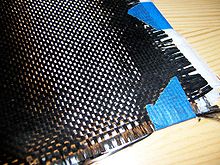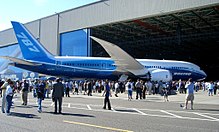User:Eas4200c.f08.vqcrew.E
Introduction to Aerospace Structures[edit]
The main consideration during the aircraft design process is to reduce weight while maintaining strength in the structure. Strength, stiffness, and toughness all play important roles in the overall performance of an aircraft. The role of a design engineer is to create a balance of these properties that best satisfies all of the requirements of the aircraft.

1. Ultimate Strength
2. Yield Strength
3. Rupture
4. Strain hardening region
5. Necking region
- Strength - the resistance of a material to deformation and rupture.
- The yield stress, , of a material is the point at which the material will begin to plastically and permanently deform.
- The ultimate stress, , of a material is the critical point at which the material fails catastrophically.
- Stiffness - the ability of a material to resist deformation caused by forces acting on the object.
- The strain, , of a material is the measure of the deformation caused by an applied force.
- Young's modulus, , is the measure of a material's stiffness. Young's modulus is the ratio of the stress applied over the strain caused in response, . Figure 1 displays the stress-strain curve for steel. Young's modulus represents the slope of the curve in the linear, or "elastic", region. In this region, no permanent or "plastic" deformation has taken place and the material will return to its original dimensions.
- Toughness - the overall resilience of a material and resistance to fracture. Toughness is measure in units of energy per unit volume a material can withstand before failure.
Examles of Materials and Their Properties[edit]
Glass - high stiffness, low toughness. Unlikely to bend or deform, yet vulnerable to fracture.
Plastics - low stiffness, high toughness. Easily deformed, but resistant to rupture.

Metals - Aluminum has high toughness, but is weak in terms of stiffness. Aluminum will not resistant deformation under high loads. Steel alloys are better suited for a situation requiring high stress handling capabilities.
All of these materials have their strengths and weaknesses. All of these materials can be used safely and effectively as long as these constraints are recognized. In the search for highly stiff, highly tough materials, the strengths of different materials were combined and their weaknesses diminished. Materials known as composites are formed from a network, or "matrix", of strong, flexible fibers held in place by stiff epoxy. The union of these materials creates a new, strong and lightweight material ideal for the aerospace industry.
| Example of the Use of Composites in the Boeing-787 Dreamliner | |
|---|---|
 |
"The 787's all-composite fuselage makes it the first composite airliner in production. While the Boeing 777 contains 50% aluminum and 12% composites, the numbers for the new airplane are 15% aluminum, 50% composite (mostly carbon fiber reinforced plastic) and 12% titanium." From Boeing-787 in Wikipedia |
In order to optimize performance, aerodynamic considerations must be made during the design process. Even though a material is structurally robust, there many be other factors that make that material detrimental to the overall function of the aircraft. For example, a material with vulnerability to cold or corrosion could not be used on the outer skin of an aircraft. The shape of major features of the aircraft must function both structurally and aerodynamically. The fuselage must be strong enough to withstand years of stress associated with pressurizing and depressurizing the aircraft while also maintaining a small cross-sectional area to keep aerodynamic drag to a minimum. The wings must be shaped to create lift to allow the aircraft to fly, but they must also act to support the weight of the fuselage.





